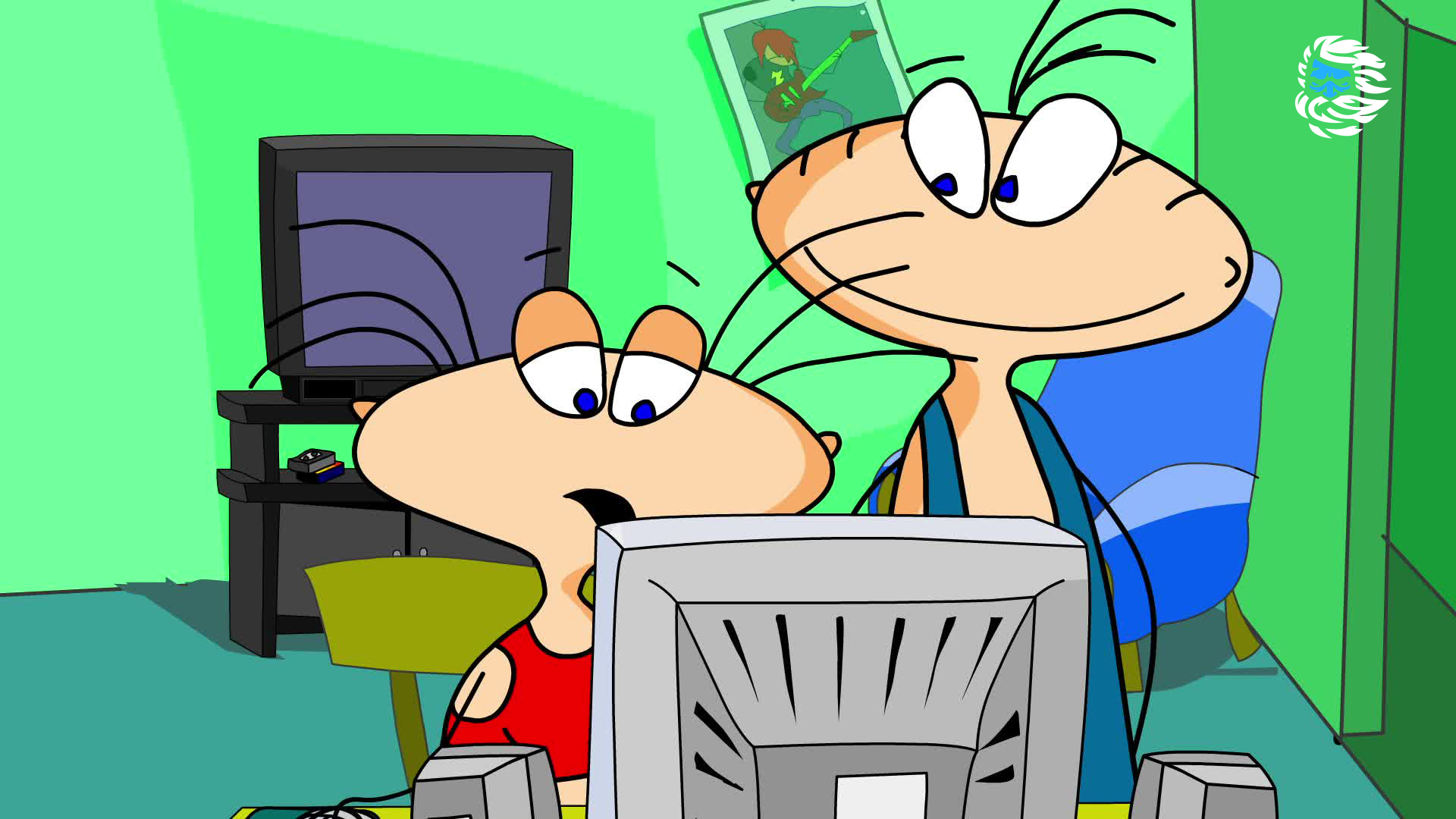
Homepage is mine, homepage is ready. I finished my site, granny!
Surprisingly, I do not remember at all the day of my acquaintance with the Internet. It was definitely 1996 or 97, but for some reason the moment itself did not remain in memory: the Internet entered the life of our generation gradually, displacing both the BBS and the Fidonet echo conference from it. At first, we were desperate for content: surfing the net in the mid-90s was like Columbus's travels in search of the unknown, and every day it brought new exciting discoveries. Then, many of the craving for creativity prevailed, and they began timid experiments to create their own "nightmarish home pages." This cup did not pass me either - the memories of how it was now cause only a nostalgic smile.
In the mid-90s, no sensible books in Russian on HTML syntax, and even more so on web design, were published. At least, my recollections of such literature date more likely to the beginning of the 2000s - then, in the wake of the popularity of the topic, such publications suddenly became unexpectedly large. I had to act experimentally: the web page was saved to disk, opened in Notepad.exe, after which the values of the attributes of html tags were changed in the code, lines were deleted and added, and the changes were immediately tracked in the browser window. Actually, my first web pages were by and large localized copies of foreign "homepages", I learned to do something really my own a little later through field experiments.
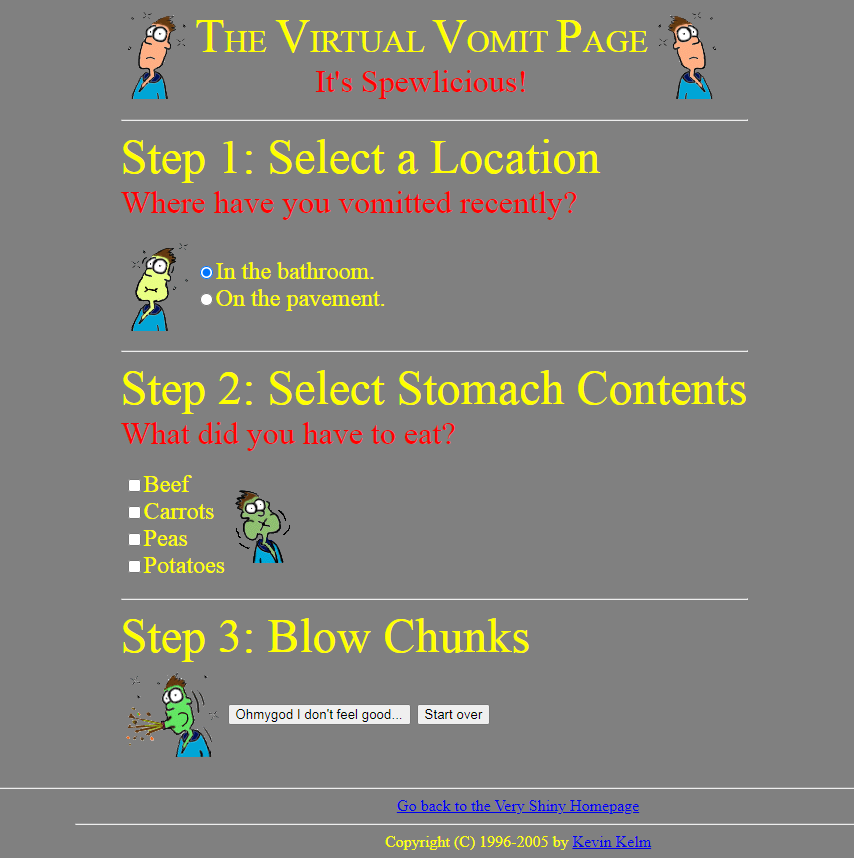
Typical site of the mid-90s. This design can really throw up these days.
A distinctive feature of the sites of that time was the widespread use of jagged-eyed background images, with which it was necessary to pave the entire space of the page from top to bottom. Therefore, it was extremely important to ensure that the small image docked correctly with itself horizontally and vertically. Someone used Photoshop for this, later there were special utilities for working with background images like Harm's Tile 99, through which it was possible to create almost perfect backgrounds for the site, spending a minimum of effort. Some "Webmasters" (that is what they called them then - in Latin letters and with a capital letter "W") loved to screw a MIDI file to some page, which, without a declaration of war, began to play immediately when the site was opened. Personally, for this I was ready to hit them with something heavy,because in order to save money, I used mainly night dial-up, and at times forgot to turn off the speakers.
The Internet then came to the population mainly by modem, therefore, to speed up page loading (and due to the hosting restrictions of that time), pictures had to be compressed. The PNG format was not yet widespread at that time (at first, additional browser plugins seemed to be required to support it). Pictures on the sites were represented by GIF files - for buttons, captions, headers, and, of course, animation, and JPEG - for everything else. We compressed JPEG using Jpeg Optimizator and Jpeg Cleaner for DOS, for the second format, GifClean 32 was widely used for Windows. Later, closer to zero, the universal program WebGraphics Optimizer became widespread: you loaded an image into it, and the tool produced several versions of a compressed image with different degrees of compression:all that was left was to choose a compromise between a suitable file size and the amount of dirt and artifacts. The "Save for Web" options in Photoshop (at least in the version I was using) did not yet exist, we survived as best we could. There was also no convenient function of cutting a picture into slices, with the help of which it was possible to assemble a whole mosaic of image fragments with different hyperlinks. Pictures were cut into pieces in the Picture Dicer program, until browsers finally learned to properly support the html <map> tag. Then this perversion was forgotten with great relief.There was also no convenient function of cutting a picture into slices, with the help of which it was possible to assemble a whole mosaic of image fragments with different hyperlinks. Pictures were cut into pieces in the Picture Dicer program, until browsers finally learned to properly support the html <map> tag. Then this perversion was forgotten with great relief.There was also no convenient function of cutting a picture into slices, with the help of which it was possible to assemble a whole mosaic of image fragments with different hyperlinks. Pictures were cut into pieces in the Picture Dicer program, until browsers finally learned to properly support the html <map> tag. Then this perversion was forgotten with great relief.

WebGraphics Optimizer –
The biggest buzz of fashion in the 90s was, of course, animated GIFs, which were collected in programs like Gif Movie Gear and Ulead GIF Animator. On the web pages, literally everything ran, jumped and spun. It was considered very correct and important to cram as many animated buttons, pictures, icons and icons on the site as possible, so that in a couple of minutes the visitor would begin to ripple in his eyes and vomit. In 1997, GIF animation also acquired practical significance: the first banner exchange network Reklama.ru appeared on the Runet, which was used for mutual promotion of sites, but at the same time took a certain part of the impressions for its own monetization. The network imposed very strict restrictions not so much on the content of banners, but on the volume of files,Therefore, sometimes individual frames in GIF format had to be first compressed with third-party compressors, and then also optimized in the GIF Animator itself, reducing the number of colors in the palette, adding transparency there and removing unnecessary layers. Sometimes it took even longer than drawing the ad itself.
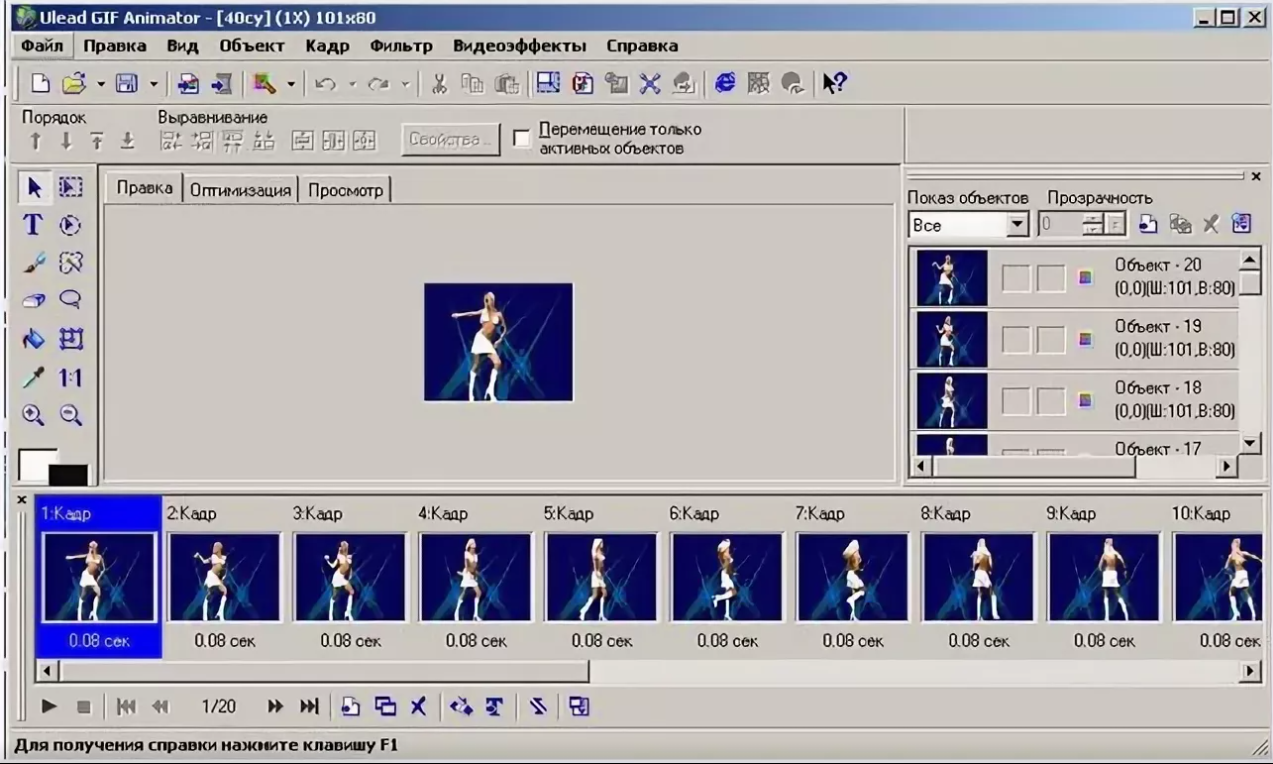
Ulead GIF Animator
The web builders of the late 90s faced three major challenges. The first is Cyrillic encodings. Browsers did not always know how to correctly recognize it in automatic mode, so sometimes they had to prepare several versions of the site - first in Windows-1251, after which copies of web pages were distilled into KOI-8, ISO-8859-5 and CP866 using utilities like ConvertHTML or Coder. Then the site variants in different encodings were linked by hyperlinks. Updating this whole zoo of web pages then poured into a separate epic. Large offices that had the ability to tweak the server configuration could configure the site to be displayed in different encodings through different http ports, but the usual mass of webmasters did not even have access to the / cgi-bin / folder, not to mention more complicated things.Therefore, the problem was solved with such handicraft methods and all kinds of props from crutches.
The second hemorrhoid is support for screen resolutions. So that nothing was dispersed and crawled on different computers, the sites of that time were wrapped in an invisible table, the width of which was determined by the most common screen resolution values. I made up my first sites for 640x480, but soon 800x600 became the most popular standard, less often there were web pages optimized for 1024x768. If you make the table too narrow - untidy empty fields will appear at the edges of the screen, too wide - scroll bars will pop out in the browser for sufferers with old displays. The debate about which resolution is considered the main one and which width of the tables to choose as the "standard" did not subside for a very long time and sometimes turned into real holivars. At least not until science came up with a "rubber" responsive design.
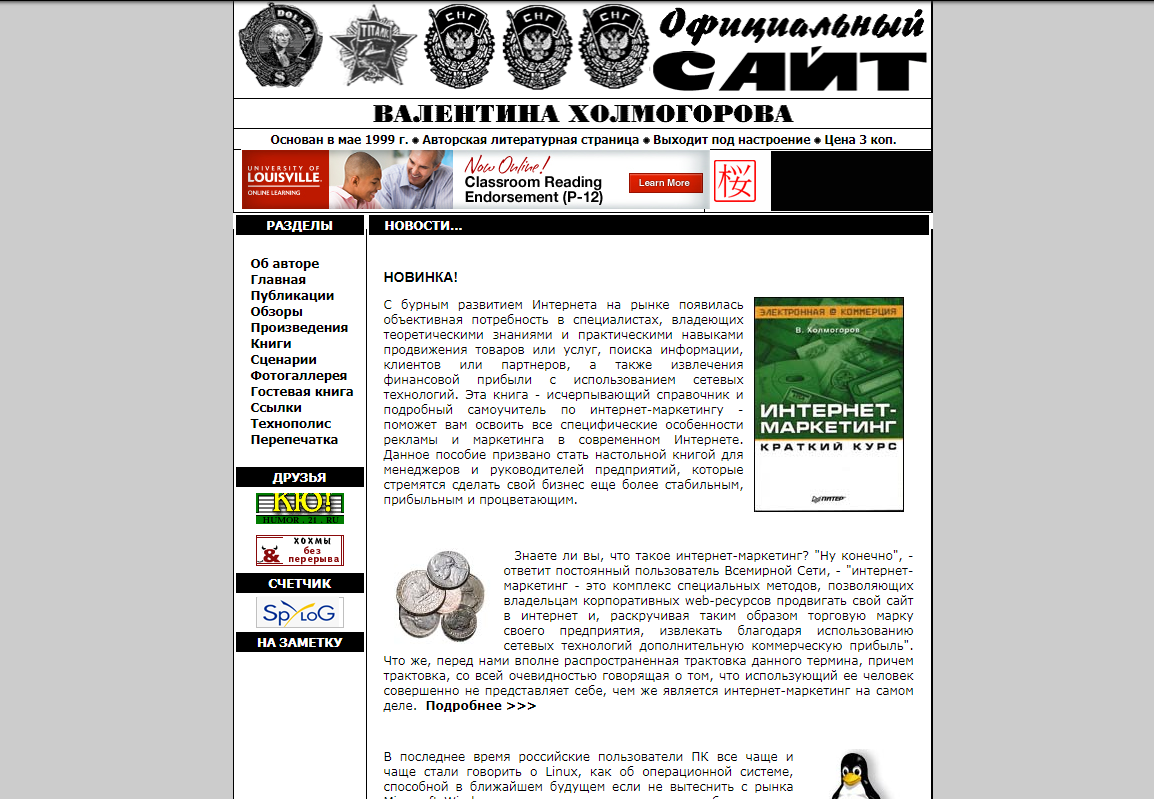
. 00-.
But the biggest headache was perhaps trying to achieve the same web page display in Internet Explorer and Netscape Navigator. During the "browser wars", developers came up with html tags that only their program normally supported, in addition, Microsoft, according to rumors, was actively feeding the W3C consortium in order to legalize its own innovations in the HTML standard. In order not to bother, many webmasters hung a disclaimer from the series "This site is best viewed in Microsoft Internet Explorer" on their pages, and went to drink beer with a clear conscience. Others like me were striving for perfection, and on long nights, cursing through clenched teeth, delved into the HTML code: as soon as you adjust the alignment of objects in IE, the width of the side navigation columns shrinks in Netcabinet, if you fix the columns, the horizontal lines disappear.If you put the lines back in place, disgusting frames have emerged from somewhere around the pictures. Still, I remember, there was a national browser "Ariadne", which was even used by ... almost no one. By the beginning of the 2000s, Opera began to gain popularity, adding a little more to the webmasters: now they had to optimize the pages for as many as three different browsers.
It's not enough to create a nightmarish home page, it still needed to be hosted somewhere. Professional hosting was expensive and not everyone could afford, but many providers, when buying Internet from them, provided the user with up to a megabyte of disk space for free. These personal sites usually had a URL like www.cityline.ru/~username... This hosting option had several serious drawbacks. First, providers usually imposed restrictions on the content of sites, allowing only personal pages to be placed and not allowing commercial ones to be published. Secondly, a couple of days after you stopped paying for the Internet, the page was simply destroyed - and if there was no backup copy left on your computer, it was no longer possible to restore it. Thirdly, you found yourself in fact tied to this office: it was not difficult to transfer a static site to another host when changing the provider, but the address registered in all Internet directories was lost forever along with the rating of Rambler's Top 100 and other honestly earned achievements ...
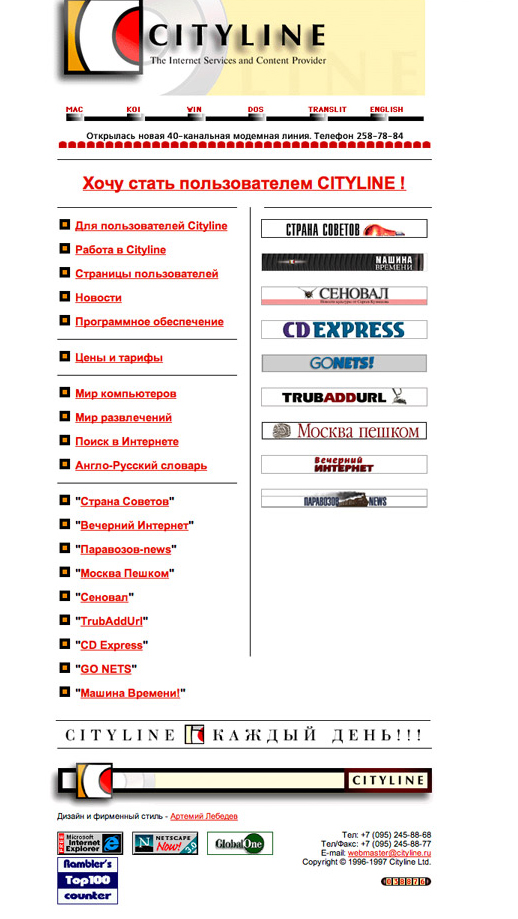
Internet provider of all Russia Cityline. Website design - studio of Artemy Lebedev
The second option is free hosting. Since 1996, the Halyava.ru portal has been operating in Runet, where it was possible, without-any-mez-bottom, that is, for nothing, to place a home page with a total volume of no more than 512 kilobytes. To the question of what dictated such a strict restriction, an exhaustive answer was published in the hoster's FAQ:
Why do you need more? If your page starts to weigh more than 512 kilobytes, the question arises: why make such "heavy" graphics?
From the generosity of the soul, the company offered for each such page an address of the form www.halyava.ru/your-name (for serious people in crimson jackets who do not like the word "Freebie", URLs of the format www.homepage.techno.ru/your- name), and also covered it with advertising. In fact, the user's site was displayed in an embedded frame, at the top of which the hoster unrolled banners and placed a link to his own service. It is noteworthy that at first, Halyava.ru did not have the ability to download web pages via FTP: instead, data was transmitted to the server by e-mail, and instructions were sent to the user via it. I remember that some of the hosters used another perverse method: they had to copy the HTML code through the clipboard into a special form, from which, by pressing the Submit button, a web page with the specified name was generated in a folder on the server. Along the way, the HTML code was checked for "forbidden" tags. The page lived on "Freebie" for two months from the moment the server received the last command from the user, and then disappeared without a trace. Naturally,such free hosting did not imply the use of any scripts: only static web pages, only hardcore! But even such spartan conditions for the 90s were considered more than acceptable. Freebie, sir!
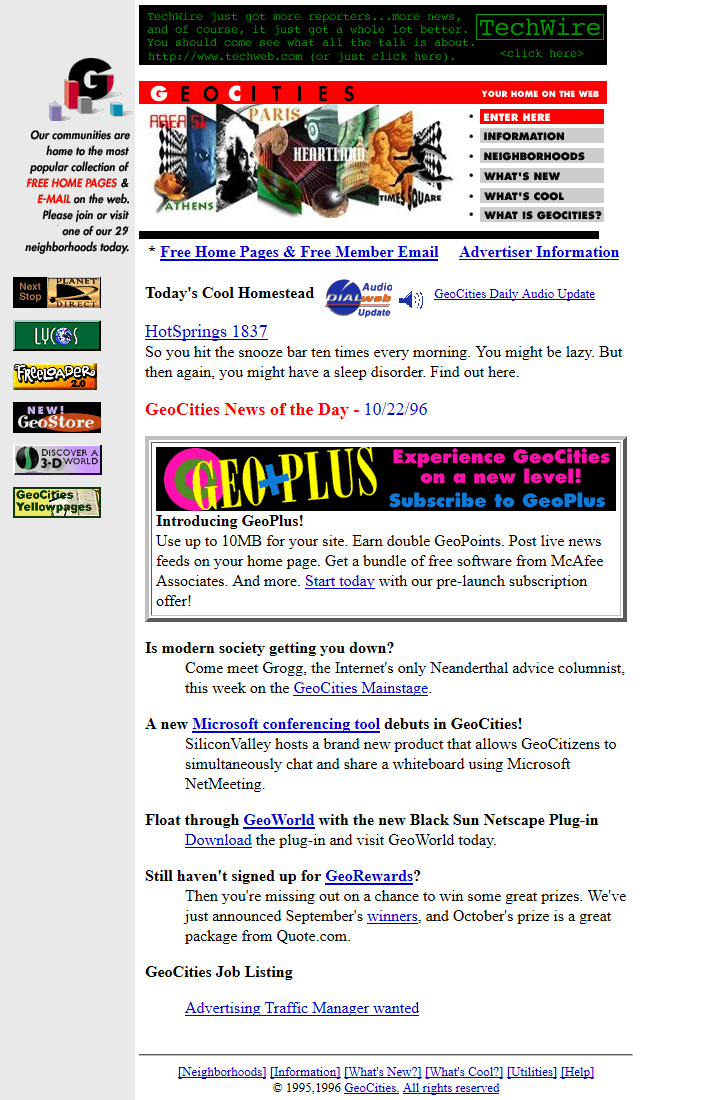
Not so many providers offered free hosting in the 90s, one of the most famous is GeoCities
For those who knew English and were not afraid to communicate with technical support in a foreign language, the whole world was open: for example, on the GeoCities server, they gave as many as 2 megabytes, and personally I used free hosting services on the Tripod.com portal. They also sculpted their own advertisements on the sites being placed, also allowed only static web pages to be published, and the site address looked like www.tripod.com/~username... GeoCities offered a free mailbox in addition to the site. In addition, normal FTP access was provided to upload web pages to the server. However, registering a new site was not an easy quest: first you had to choose a suitable thematic heading in the catalog, then find an unoccupied name, and only then you were admitted to the holy of holies - to fill out an application form to receive a membership. Perhaps it was precisely such a non-trivial system that scared away our compatriots. On the other hand, the Americans, unlike local hosters, did not limit the placement of third-party advertisements on user web pages. Thanks to participation in affiliate programs, I remember, even earned as much as 15 bucks, and then ran for a long time around Russian banks with a paper check sent to me by mail, trying to cash it out.
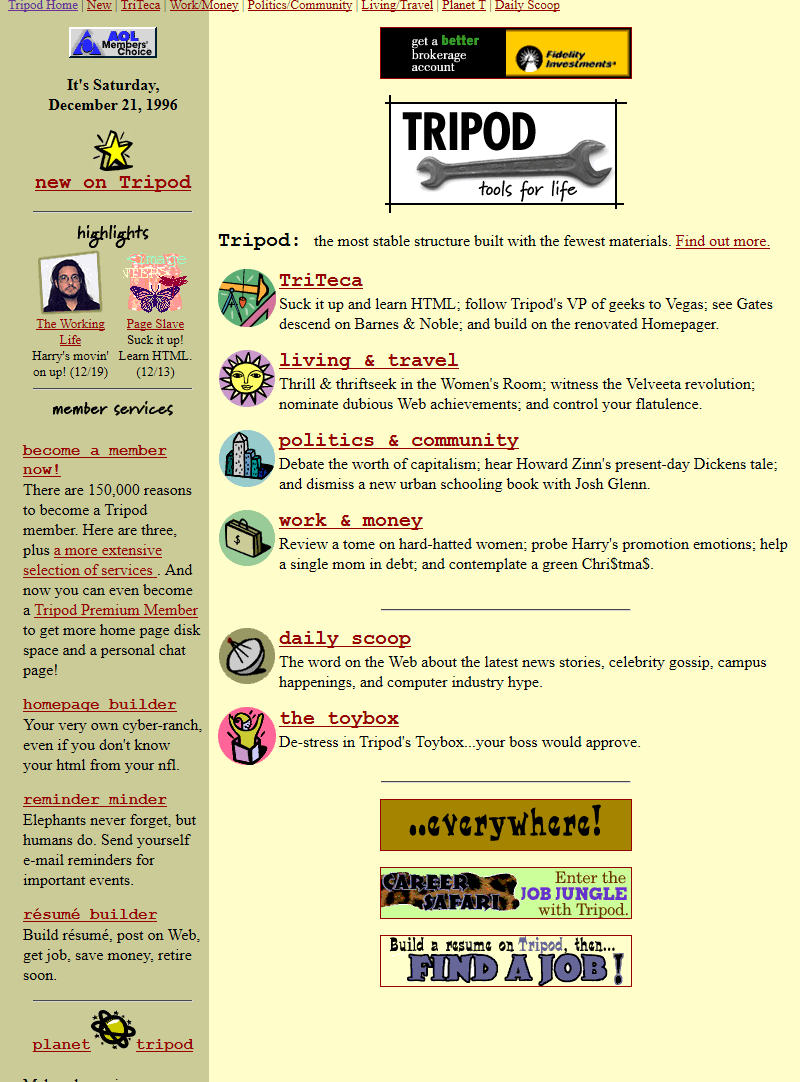
Another paradise for lovers of freebies from the 90s - Tripod
Soon other sites for free site placement began to appear in Runet, developers had the opportunity to register third-level domains for them or create aliases like site.da.ru. But, nevertheless, the launch of scripts was still inaccessible to most users of free plans. The most popular web services at the time were guest books and chats, and the most common language for writing CGI scripts was Perl. Of course, you could attach a third-party guestbook with someone else's advertising to your website - there were a lot of such offers on the RuNet - but everyone, of course, wanted to have their own chat room like the legendary "Bed", or a cozy "guest girl" neatly inscribed into the existing design ...
Since Perl, in the event of an incorrect server configuration (and not everyone was allowed to configure it correctly) technically allowed executing operating system commands and accessing files outside the user's home folder, and scripts created a load on the server, access to / cgi-bin / was simple mortals were not always discovered. Most often, the "free" user was asked to write to the hosting administrator what kind of script he wants to run on the server and why he needed it. Then it was necessary to send the script for consideration, and only if approved, the admin uploaded it to the site and gave it execution rights. At the same time, debugging Perl scripts turned into sheer torture, and the task of fixing an incorrectly specified path or an error in a variable name somewhere was mission impossible. Access to the DBMS on free tariffs too, of course,was absent as a phenomenon, the data was written to text files that were used instead of the database. Archaic, but the chat in Perl and .TXT successfully existed on my site, it seems, until 2002, when it was discontinued as unnecessary. We wrote the scripts ourselves, but it was possible to get by with ready-made options - a huge selection of various scenarios for all occasions could be obtained in collections like freeware.ru - there was just a storehouse of scripts and useful software for all occasions. Free hosting with full access to CGI became widely available only at the very beginning of the 2000s; commercial users, for obvious reasons, had not experienced such problems before.TXT successfully existed on my site, it seems, until 2002, when it was discontinued as unnecessary. We wrote the scripts ourselves, but it was possible to get by with ready-made options - a huge selection of various scenarios for all occasions could be obtained in collections like freeware.ru - there was just a storehouse of scripts and useful software for all occasions. Free hosting with full access to CGI became widely available only at the very beginning of the 2000s; commercial users, for obvious reasons, had not experienced such problems before.TXT successfully existed on my site, it seems, until 2002, when it was discontinued as unnecessary. We wrote the scripts ourselves, but it was possible to do with ready-made versions - a huge selection of various scenarios for all occasions could be obtained in collections like freeware.ru - there was just a storehouse of scripts and useful software for all occasions. Free hosting with full access to CGI became widely available only at the very beginning of the 2000s; commercial users, for obvious reasons, had not experienced such problems before.ru - there was just a storehouse of scripts and useful software for all occasions. Free hosting with full access to CGI became widely available only at the very beginning of the 2000s; commercial users, for obvious reasons, had not experienced such problems before.ru - there was just a storehouse of scripts and useful software for all occasions. Free hosting with full access to CGI became widely available only at the very beginning of the 2000s; commercial users, for obvious reasons, had not experienced such problems before.
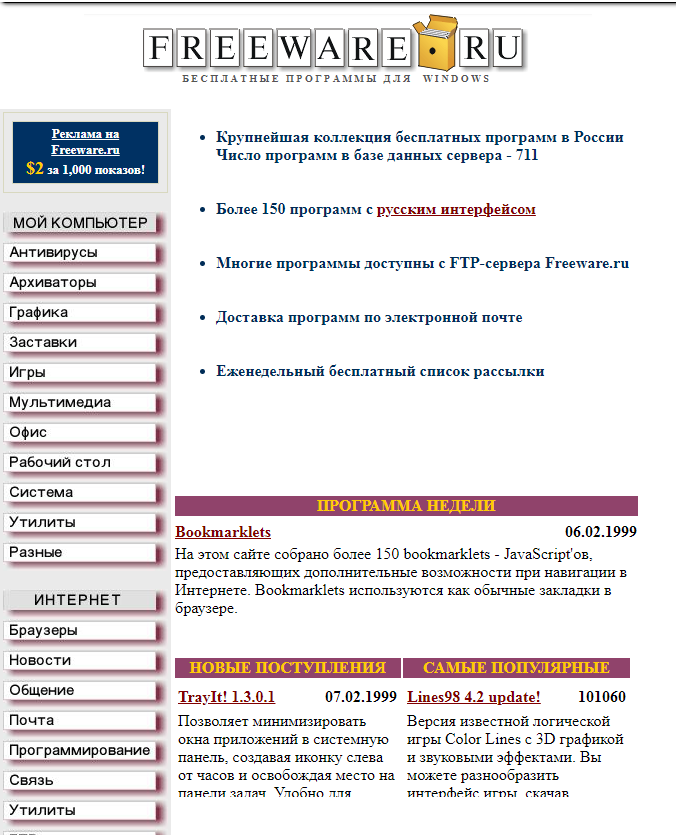
Freeware.ru - a deposit of software and useful scripts
The real revelation in the late 90s for me was the CSS standard, which I learned about from colleagues. It turns out that it is completely unnecessary to write a bunch of attributes in each html tag, but instead you can collect all the styles in one external text file. The second big discovery was Server Side Includes, which saved tons of time updating content. With the help of SSI, it became possible for the first time to separate the design from the actual content of the site: the webmaster could cram the header, footer, navigation and content into different files, and then dynamically collect them together right on the server. I wanted to edit the menu on all pages of the project - it is enough to make edits to only one file. "U" stands for convenience. There was exactly one step to the advent of full-fledged CMS.
Instead of them, at the beginning of the 2000s, editors like HomeSite, Hot Metal Pro, Adobe Page Mill, Hotdog, Macromedia DreamWeaver, and of course, Microsoft FrontPage, which generated hellish amounts of junk code, made life much easier for a webmaster, but I really fell in love with clarity and simplicity. Yes, the code of the web pages after FrontPage had to be cleaned up in Notepad, but it was an integral part of the workflow.

A lot of web pages were laid out in Microsoft FrontPage
At that time, the West was experiencing the peak of the famous "dot-com bubble", and in the Russian segment of the network, the rapid growth of new projects began, some of which later turned into large Internet companies with multimillion-dollar capitalization. But that was later. At the same time, the overwhelming majority of Russian-language sites were created on sheer enthusiasm and supported by financial resources and personal time of the developers themselves. Many then rightly thought that there was no money on the Runet. Me and a couple of my friends "cheated" in a different way, namely, we made websites for American customers, mainly for small and mid-sized businesses. In the States, such services were then expensive, in Russia - much cheaper. I remember how I was thrown into a complete stupor by a question from a gentleman from Texas, how many dollars an hour of a webmaster's work costs in Russia.Yes, the dog knows him! In Russia in the late 90s, people usually paid for a completed project, and even then not always. Some students worked for beer at all. I remember at that time we made a homepage for a bakery from Alabama, for a religious community from Pennsylvania, for a family business offering tourist transfers by minivan from LaGuardia airport, for a small beauty salon and a private pool cleaner from the Texas hinterland. , for a lawn mower store from a town that I could not even find on the map ... Not at all million dollar startups, of course, but it brought some money. Moreover, our small gang of webmasters did not give any advertising: a simple knowledge of English was enough for orders to come one after another through word of mouth.and even then not always. Some students worked for beer at all. I remember at that time we made a homepage for some bakery from Alabama, for a religious community from Pennsylvania, for a family business offering tourist transfers by minivan from LaGuardia airport, for a small beauty salon and a private pool cleaner from the Texas hinterland. , for a lawn mower store from a town that I could not even find on the map ... Not at all million dollar startups, of course, but it brought some money. Moreover, our small gang of webmasters did not give any advertising: a simple knowledge of English was enough for orders to come one after another through word of mouth.and even then not always. Some students worked for beer at all. I remember at that time we made a homepage for a bakery from Alabama, for a religious community from Pennsylvania, for a family business offering tourist transfers by minivan from LaGuardia airport, for a small beauty salon and a private pool cleaner from the Texas hinterland. , for a lawn mower store from a town that I could not even find on the map ... Not at all million dollar startups, of course, but it brought some money. Moreover, our small gang of webmasters did not give any advertising: a simple knowledge of English was enough for orders to come one after another through word of mouth.for a religious community in Pennsylvania, for a family business offering minivan transfers from LaGuardia airport, for a small beauty parlor and private pool cleaner in the Texas outback, for a lawn mower store from a town I couldn't even find on the map ... Not at all million-dollar startups, of course, but it brought some money. Moreover, our small gang of webmasters did not give any advertising: a simple knowledge of English was enough for orders to come one after another through word of mouth.for a religious community in Pennsylvania, for a family business offering minivan transfers from LaGuardia airport, for a small beauty parlor and private pool cleaner in the Texas outback, for a lawn mower store from a town I couldn't even find on the map ... Not at all million-dollar startups, of course, but it brought some money. Moreover, our small gang of webmasters did not give any advertising: a simple knowledge of English was enough for orders to come one after another through word of mouth.which I could not even find on the map ... Not at all million dollar startups, of course, but it brought some money. Moreover, our small gang of webmasters did not give any advertising: a simple knowledge of English was enough for orders to come one after another through word of mouth.which I could not even find on the map ... Not at all million dollar startups, of course, but it brought some money. Moreover, our small gang of webmasters did not give any advertising: a simple knowledge of English was enough for orders to come one after another through word of mouth.
When PHP finally ousted Perl from the Internet, a web programmer could be considered a real man only if he mastered three main achievements in his life: planting a liver, growing patles and writing his own CMS. The number of self-written engines with approximately the same functionality, reminiscent of bicycles with square, triangular, trapezoidal and even Mobius strip wheels, quickly exceeded all reasonable limits. But by that time I had already completely tied up with web design and all this orgy passed me by safely. Moreover, by this time the Internet as a whole had acquired its modern form, was finally commercialized, and professionals who had mastered a truly industrial scale of production at industrial prices began to engage in web development.And for me, web design has never been the main profession and the main source of income. I liked writing texts much more.
However, it is said that quitting messing with websites is sometimes even more difficult than quitting smoking. At times I still do stuff in Joomla and WordPress for my own pleasure. But every time, opening my old archives, I remember with a smile the days when we wrote sites in Notepad.exe, manually optimized each picture before uploading, and most importantly, we learned by trial and error, without videos on YouTube, online courses, etc. even without special literature. We did not have so many public services at our disposal, ranging from engines for every taste to visual constructors, with which you can sketch a workable landing page with your mouse in a couple of minutes, sipping coffee and looking at TikTok with one eye. And Runet was tiny, like a children's sandbox in the yard, and its population, like the population of that sandbox, was more naive,good-natured and open. Those were good times.
